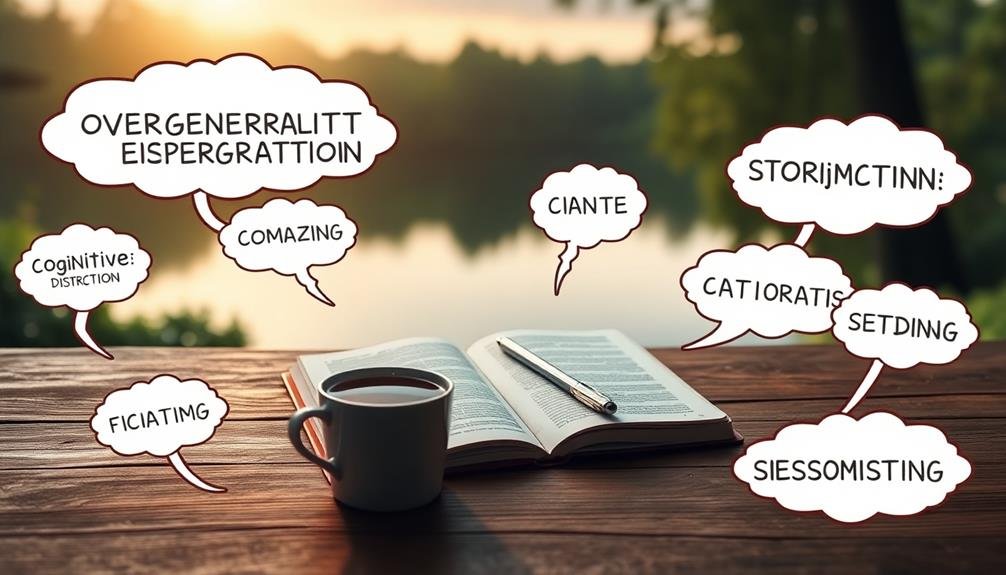Journaling can teach you a lot about your thoughts and emotions. When you write regularly, you start to recognize patterns in your thinking, which can reveal cognitive distortions like negative self-talk or catastrophizing. By exploring these patterns, you enhance your self-awareness and clarify your feelings. Writing also serves as a powerful emotional release, helping you process difficult emotions and identify triggers. As you track your thoughts over time, you can set goals and develop coping strategies. Ultimately, journaling equips you with tools to understand yourself better and make positive changes in your life. There's even more to discover.
Understanding Your Thought Patterns

Many people overlook the importance of understanding their thought patterns, but doing so can profoundly impact your mental well-being. Your thoughts shape your reality, influencing how you perceive situations and respond to challenges. By recognizing these patterns, you can identify negative or unproductive thoughts that may be holding you back.
Start by paying attention to your inner dialogue. Are you quick to criticize yourself? Do you often jump to conclusions? Noticing these tendencies can help you challenge and reframe them. For instance, when you catch yourself thinking, "I always fail," try replacing it with a more balanced perspective, like, "I've faced challenges, but I've also succeeded."
Journaling can be a powerful tool in this process. As you write, you'll uncover recurring thoughts and beliefs that may not serve you well. This self-awareness can lead to deeper insights, allowing you to understand why you think the way you do.
Over time, you'll develop healthier thought patterns and enhance your emotional resilience. So grab a journal, start documenting your thoughts, and pave the way for a more positive mindset. Your mental health will thank you!
Emotional Release Through Writing
Writing serves as a powerful outlet for emotional release, allowing you to express feelings that might be difficult to articulate otherwise. When you put pen to paper, it can feel like a weight lifts off your shoulders. Each word captures your emotions, providing a safe space for vulnerability.
| Emotion | Writing Activity | Impact |
|---|---|---|
| Anger | Free writing | Helps process frustration |
| Sadness | Letter writing | Aids in closure |
| Anxiety | Journaling prompts | Reduces overwhelming thoughts |
| Joy | Gratitude lists | Enhances positive feelings |
Identifying Cognitive Distortions

When you journal, you can start spotting common cognitive distortions that affect your thinking.
Recognizing these patterns helps you gain clarity and challenge unhelpful thoughts.
Common Cognitive Distortions
Over time, you might notice patterns in your thoughts that lead to negative feelings and behaviors—these are known as cognitive distortions. Common cognitive distortions include all-or-nothing thinking, where you see situations in black or white, ignoring any gray areas.
You might also encounter overgeneralization, where one negative experience leads you to believe that all future situations will turn out the same way.
Another common distortion is mental filtering, which involves focusing solely on the negative aspects of a situation while ignoring the positives.
Catastrophizing is another trap you might fall into, causing you to envision the worst possible outcomes instead of a balanced perspective.
Additionally, you may engage in emotional reasoning, believing that your feelings reflect reality.
Labeling and mislabeling can also distort your self-image, as you might define yourself by a single mistake instead of seeing the whole person you are.
Finally, you might find yourself engaging in "should" statements, creating unrealistic expectations that lead to frustration.
Recognizing these cognitive distortions is the first step toward challenging and reframing them, allowing you to cultivate a more balanced mindset.
Journaling for Clarity
Recognizing cognitive distortions is an important first step, but how do you make sense of them? Journaling can be your powerful tool for clarity. By writing down your thoughts, you create space to examine them critically.
Start by identifying moments when you feel overwhelmed or anxious. What're you telling yourself in those moments?
Once you've captured your thoughts, look for patterns. Do you often engage in all-or-nothing thinking, or maybe you catastrophize situations? Highlight these distortions in your journal. This awareness is essential; it helps you challenge and reframe negative thoughts.
After identifying these distortions, ask yourself questions. What evidence supports this thought? Is there an alternative perspective?
Enhancing Self-Awareness
Through journaling, you can greatly enhance your self-awareness by exploring your thoughts and feelings more deeply. When you take the time to write, you're giving yourself a space to reflect on your experiences and emotions. This act encourages you to dig beneath the surface, helping you identify patterns in your thoughts and behaviors.
As you journal, you might notice recurring themes that reveal your values, beliefs, and triggers. By recognizing these elements, you can gain insights into how they influence your daily life. For instance, you may find that certain situations consistently provoke anxiety or joy, allowing you to understand your emotional responses better.
Additionally, journaling helps you articulate your thoughts clearly. You might discover that what seemed chaotic in your mind becomes structured on the page. This clarity can shift your perspective, enabling you to approach challenges with a more informed mindset.
Ultimately, the more you write, the more you'll learn about yourself. Journaling isn't just about recording events; it's a tool for self-discovery. Embrace this practice, and you'll find yourself growing in self-awareness, which can lead to more intentional living.
Setting Goals and Intentions

Setting aside time for journaling allows you to clearly define your goals and intentions. When you put pen to paper, it becomes easier to articulate what you truly want in life. This practice helps you align your daily actions with your long-term aspirations.
Here's how journaling can guide you in setting meaningful goals:
- Clarify Your Vision: Write down what you want to achieve in different areas of your life, such as career, health, and relationships.
- Break It Down: Divide larger goals into smaller, manageable steps. This makes them less overwhelming and more achievable.
- Set Deadlines: Assign specific timelines to your goals. Deadlines create a sense of urgency and keep you accountable.
- Reflect and Adjust: Regularly review your goals in your journal. This allows you to adapt your plans based on your progress and changing circumstances.
Problem-Solving Through Reflection
When you reflect on your thoughts through journaling, you can spot recurring patterns that influence your decisions.
This process also allows you to explore your emotional responses, helping you understand why you feel a certain way.
With this clarity, you're better equipped to generate creative solutions to the challenges you face.
Identify Thought Patterns
Recognizing your thought patterns can be a powerful tool for problem-solving and personal growth. When you take the time to journal, you create a space to analyze how you think and react to different situations.
This process helps you identify recurring themes in your thoughts, allowing you to tackle issues more effectively.
Here are four ways to identify your thought patterns through journaling:
- Daily Reflection: Write down your thoughts at the end of each day. Note any emotions or situations that triggered specific thoughts.
- Categorization: Group similar thoughts together. Are they mostly negative, anxious, or optimistic? This helps reveal dominant patterns.
- Questioning: Challenge your thoughts by asking why you feel a certain way. What evidence supports or contradicts these thoughts?
- Track Changes: Revisit previous entries to see how your thoughts have evolved. Are you stuck in a particular mindset, or are you growing?
Explore Emotional Responses
Identifying thought patterns lays the groundwork for exploring your emotional responses. Once you recognize the thoughts that trigger specific feelings, you can dive deeper into understanding those emotions.
Journaling acts as a mirror, reflecting how you react to situations, and it encourages you to confront your feelings head-on. When you write about an emotional response, ask yourself questions like, "Why did I feel this way?" or "What triggered this emotion?" This self-inquiry helps you uncover underlying beliefs or fears that may be influencing your feelings.
For instance, if you often feel anxious before social events, jotting down your thoughts can reveal whether it's rooted in past experiences or self-doubt.
As you reflect, pay attention to the connections between your thoughts and emotions. You might notice patterns, such as feeling sad after thinking about a particular event or person. By recognizing these links, you can begin to understand the emotional weight they carry.
This exploration isn't just about labeling emotions; it's about gaining insight into your emotional landscape, paving the way for healthier emotional responses in the future.
Generate Creative Solutions
Tapping into your thoughts through journaling can spark innovative solutions to problems that seem insurmountable. When you write, you create a space for reflection that can lead to breakthroughs.
Here's how you can use journaling to generate creative solutions:
- Identify the Problem: Clearly define the issue you're facing. Writing it down helps you see it from different angles.
- Brainstorm Ideas: Allow yourself to jot down any solutions that come to mind, no matter how unconventional. This freewriting can reveal hidden creativity.
- Evaluate Your Options: Review your brainstormed ideas. What stands out? What feels feasible? Highlight the most promising solutions.
- Plan Your Next Steps: Choose one or two ideas to develop further. Create a plan of action that outlines how you can implement these solutions.
Developing Mindfulness Practices

Mindfulness practices can transform your daily routine into a more intentional experience. By incorporating mindfulness into your journaling, you become more aware of your thoughts and feelings.
Start by setting aside a few minutes each day to focus solely on your breathing. As you inhale and exhale, let go of distractions and allow your mind to settle.
Next, when you journal, write without judgment. Capture your thoughts as they come, observing them without getting caught up in any negativity. This practice helps you recognize patterns in your thinking and encourages a more compassionate view of yourself.
Consider using prompts that encourage reflection, such as "What am I feeling right now?" or "What thoughts are occupying my mind?"
Another technique is to practice gratitude within your journal. Each day, jot down three things you're grateful for. This simple act can shift your mindset, making it easier to focus on the positive aspects of your life.
Tracking Progress Over Time
When you track your progress over time, you gain valuable insights into your personal growth and evolving thought patterns. Journaling allows you to see how your feelings, beliefs, and behaviors shift, helping you to identify patterns and triggers.
This reflection nurtures self-awareness and can motivate you to continue your journey of self-discovery.
Consider these steps to effectively track your progress:
- Set Clear Goals: Define what you want to achieve in your journaling. This could be emotional clarity, improved mood, or better relationships.
- Regularly Review Entries: Take time each week or month to read previous entries. Notice any recurring themes or changes in your thoughts.
- Celebrate Small Wins: Acknowledge your achievements, no matter how minor they may seem. This reinforces positive behavior and encourages further progress.
- Adjust Your Approach: As you discover more about yourself, be open to modifying your goals or techniques. Flexibility is key to personal growth.
Building Resilience and Coping Skills

As you track your progress and gain insights into your thoughts and feelings, you'll find that building resilience and coping skills becomes a natural extension of your journaling practice. Each entry helps you identify patterns in your emotional responses, enabling you to understand how you handle stress and adversity.
When you confront challenges on paper, you create a space for reflection. This process allows you to explore different perspectives and responses to difficult situations. You might notice recurring themes, prompting you to develop healthier coping strategies. For example, you could start replacing negative self-talk with affirmations or problem-solving techniques.
By regularly expressing your thoughts, you enhance your emotional vocabulary, making it easier to articulate feelings when they arise. This clarity can lead to more effective coping mechanisms and a stronger sense of self. Over time, you'll likely recognize your growth, becoming more adept at managing life's ups and downs.
Ultimately, journaling serves as a training ground for resilience. Each word you write equips you with tools to face challenges head-on, fostering a mindset that embraces change and uncertainty with confidence.
Embrace this journey; it's a powerful way to cultivate inner strength.
Frequently Asked Questions
How Often Should I Journal for Best Results?
You should aim to journal daily for best results. Consistency helps you process thoughts effectively. If daily feels overwhelming, try three to four times a week. Find a rhythm that works for you and stick with it.
Can Journaling Replace Therapy or Counseling?
Journaling can't fully replace therapy or counseling. While it helps you process emotions, gain insights, and reflect, a professional therapist offers guidance, tools, and support that journaling alone doesn't provide for deeper issues.
What Tools or Apps Can Enhance My Journaling Experience?
To enhance your journaling experience, try apps like Day One or Journey for organization. You might also use prompts from websites, voice-to-text features for convenience, or even art supplies to express your thoughts creatively.
Is There a Specific Time of Day That's Best for Journaling?
You'll find the best time for journaling varies. Many prefer mornings for clarity, while others like evenings to reflect. Experiment with different times to see when your thoughts flow most freely and authentically.
How Do I Start Journaling if I Have Writer's Block?
If you're facing writer's block, start small. Write a single sentence about your day, your feelings, or a random thought. Don't worry about perfection; just let your pen flow and see where it takes you.
In Summary
Journaling offers you a powerful way to explore your thoughts and emotions. By understanding your thought patterns and identifying cognitive distortions, you can enhance your self-awareness and develop mindfulness. It helps you release emotions, set goals, and solve problems through reflection. As you track your progress over time, you'll build resilience and coping skills that empower you to face challenges. So grab a pen and start journaling—your insights await!





Leave a Reply